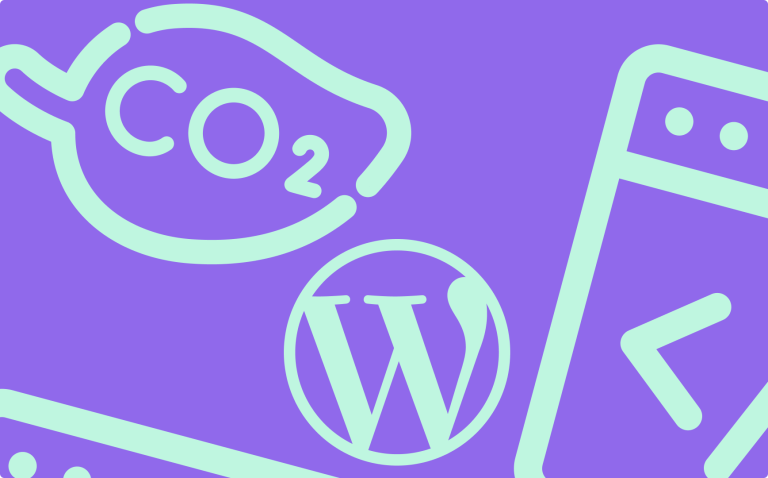
Responsibility, Technology
How to make your WordPress website more energy efficient
Tuomo Karvinen, Tea Dickman, Matti Muurinen
WordPress remains the world's most popular Content Management System (CMS) with a 43.5% market share, but its popularity doesn't guarantee energy efficiency. Quite the opposite, in fact: without conscious technical choices and optimization, a WordPress site can consume a significant amount of energy. In this blog post, we'll dive into how to build WordPress sites that are energy efficient—without compromising usability or visual appeal.
Why is energy efficiency important in digital services?
The digital world is not immaterial. Every website load consumes energy—on servers, across networks, and on the end-user’s device. The ICT sector’s carbon footprint already accounts for over 5% of global emissions, and it’s growing.
The good news is that digital services can be built more sustainably, and energy efficiency often goes hand-in-hand with better usability and performance. Lightweight, technically well-built, and fast-loading websites also rank higher in search results. A more sustainable digital service isn’t just a responsible choice; it’s also a smart business decision.
So, is WordPress an energy guzzler?
Let’s look at the facts: By default, WordPress is not a particularly lightweight content management system. Compared to lightweight headless CMS solutions or platforms built from the ground up using modern technologies (such as Node.js or statically generated content), WordPress can lag behind in performance (Ranking programming languages by energy efficiency, 2021). Reasons for this include its age, an architecture that favors backward compatibility, and its traditional database structure, which often demands more queries and resources than modern, API-driven solutions.
Where does WordPress’s load come from – and how can it be optimized?
WordPress’s popularity isn’t accidental, but it comes with technical compromises. The platform’s load stems from various factors, and understanding these is key to effective optimization and energy efficiency.
Key sources of load include:
- PHP programming language: WordPress runs on PHP, which isn’t among the most energy-efficient programming languages. Compared to modern technologies like Node.js or static site generators, PHP-based solutions can be resource-intensive to run.
- The weight of history: WordPress’s long history and large user base have led to a strong focus on maintaining compatibility with older plugins and themes. As a result, the platform retains many legacy structures and solutions that no longer align with modern best practices.
- Heavy database: WordPress uses a relational database (typically MySQL or MariaDB), where even seemingly simple content can require multiple background queries. On unoptimized pages, these queries accumulate and cause significant load.
- Monolithic structure: WordPress’s code and content typically run together in a single package on the server. This monolithic nature has traditionally made scaling difficult and limited opportunities to leverage distributed, energy-efficient architectures.
So, what’s the solution? While WordPress’s technical foundation sets certain limitations, there is still a lot that can be optimized and improved.
Five tips for a more energy-efficient WordPress
Despite everything, WordPress’s energy efficiency can be significantly improved. With smart development, effective caching, and content optimization, we can build modern and sustainable WordPress sites — without having to compromise on user experience.
1. Lightweight content is a sustainable choice
Visuals are a crucial part of the digital customer experience, but every extra image, animation, or video increases a website’s data volume and energy consumption. Therefore, when creating content, it’s wise to embrace the idea that “less is more.” Every element should have a clear purpose. At the same time, remember that lighter content often loads faster and performs better on various devices.
It’s especially important to consider loading speeds when conducting international business, as internet speeds vary by country. Mobile internet speeds comparable to Finland’s aren’t as widely available in other countries, meaning websites need to be particularly lightweight to load quickly everywhere.
If, after careful consideration, you still feel the need for something visually “sweet,” animations or videos can, where possible, be created programmatically (e.g., animated SVG). This results in a lighter outcome compared to traditional video.
2. Optimize image formats
When it comes to images, modern formats like WebP, AVIF, and SVG offer both energy efficiency and high quality. They reduce the amount of data transferred without compromising the visual experience. Additionally, responsive images—meaning versions optimized for specific devices—ensure users don’t download unnecessarily large files. Optimizing image sizes and critically reviewing media files are simple yet impactful steps toward a more energy-efficient web.
While the use of new formats can be handled with custom project solutions, it’s often better to leverage ready-made options, such as high-quality plugins or a CDN service that provides modern image formats. When choosing a CDN, remember to consider data privacy.
3. Caching and redis – efficiency implemented correctly
Smart caching is one of the most crucial ways to improve a WordPress site’s performance and energy efficiency. Common caching plugins like WP Rocket or WP Super Cache offer quick benefits, especially in simple environments. However, Redis provides a more sustainable and efficient solution, which we recommend particularly for the needs of larger and more dynamic websites.
Redis reduces server load and speeds up page loading, especially in search functions, which directly translates to both energy efficiency and a better user experience. When Redis is implemented thoughtfully as part of the overall architecture, it supports the digital service’s performance in the long run.
4. Serverless – energy only when it’s needed
In traditional server environments, servers often run continuously, easily leading to underutilized resources and unnecessary energy consumption. Serverless architecture — for instance, in Google Cloud’s Cloud Run environment — provides capacity only when needed and scales automatically in both directions. When there’s no traffic, no energy is consumed.
Serverless is, above all, a resource-smart choice: it reduces the infrastructure’s environmental footprint and supports cost-efficiency without compromising performance. At Hion, we primarily leverage serverless architecture for dynamic services where minimizing energy waste caused by fluctuating loads is crucial.
5. Flexible Architecture and Limited Load
WordPress’s monolithic structure can pose challenges for energy efficiency, but a flexible architecture allows for smarter load distribution. Not everything needs to—or always should—be executed in the same environment. This requires a new way of thinking about WordPress development, but it opens doors to more modern architectures.
For example, form handling, integration data transfer, or search functionalities can be outsourced to cloud-based functions, such as Cloud Functions. This way, heavy operations don’t burden the main website; instead, they are executed in separately optimized environments. This improves performance, reduces server load, and adds scalability.
Energy efficiency in service development starts with small decisions
Optimizing WordPress isn’t a single action, but part of a broader, responsible design approach. Sustainable digital service development is built on the same principles as quality web service design: user-centricity, accessibility, and clear, efficient technical solutions. As Hion’s Customer Guide to Reducing the Carbon Footprint of Digital Services reminds us, every added functionality, image, or external integration increases a service’s energy consumption.
Therefore, the core of development should be a continuous evaluation: does this add value for the user — and is it worth the energy it consumes?
Sustainable development isn’t the opposite of a good user experience. Quite the contrary: when a service is designed resource-efficiently, the result is often a faster, more consistent, and clearer overall experience for the user. For example, effectively utilizing caching and CDNs, trimming unnecessary data and media, and optimizing server location are all ways to reduce the carbon footprint — while simultaneously improving performance.
At Hion, these principles are an essential part of every project. We believe that digital services should be not only user-friendly and accessible but also genuinely sustainable — now and in the future.
Check out our client projects with Hamina and Autoklinikka, where we’ve successfully improved service performance.
Don’t go it alone – we’re here to help
Improving the energy efficiency of a WordPress site might seem complex, but when done right, it’s a smart investment – not just for the environment, but also in terms of performance and user experience.


